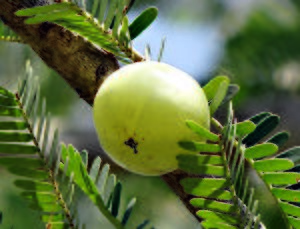Note: This is a project under development. The articles on this wiki are just being initiated and broadly incomplete. You can Help creating new pages.
Difference between revisions of "Phyllanthus emblica - Emblic, Amalaki"
(→Chemical Composition) |
(→References) |
||
| Line 62: | Line 62: | ||
<references> | <references> | ||
| − | <ref name="chemical composition">[ | + | <ref name="chemical composition">[http://www.itmonline.org/arts/amla.htm "EMBLIC MYROBALANS"]</ref> |
<ref name="Leaf">[https://indiabiodiversity.org/species/show/8066 "morphology"]</ref> | <ref name="Leaf">[https://indiabiodiversity.org/species/show/8066 "morphology"]</ref> | ||
</references> | </references> | ||
Revision as of 16:08, 5 April 2018
Phyllanthus emblica tree is small to medium in size, reaching 1–8 m (3 ft 3 in–26 ft 3 in) in height. The branchlets aren't glabrous or finely pubescent, 10–20 cm (3.9–7.9 in) long, usually deciduous.
Contents
Uses
heart attack, fast heartbeat, high blood presure, migraine, sheen of the hair.
Parts Used
Bark, Seeds, Leaves, Fruits, Flowers.
Chemical Composition
Although these fruits are reputed to contain high amounts of ascorbic acid (vitamin C), up to 445 mg per 100 g, the specific contents are disputed, and the overall bitterness of amla may derive instead from its high density of ellagitannins, such as emblicanin A (37%), emblicanin B (33%), punigluconin (12%) and pedunculagin (14%).It also contains punicafolin and phyllanemblinin A, phyllanemblin other polyphenols, such as flavonoids, kaempferol, ellagic acid, and gallic acid.[1]
Common names
| Language | Common name |
|---|---|
| Kannada | Bettada nelli |
| Hindi | Aavala |
| Malayalam | |
| Tamil | |
| Telugu | |
| Marathi | NA |
| Gujarathi | NA |
| Punjabi | NA |
| Kashmiri | NA |
| Sanskrit | |
| English | Emblic |
Habit
Identification
Leaf
{{Leaf|Simple|subsessile|the leaves are closely set along branchlets, light green, resembling pinnate leaves}.[2]
Flower
| Type | Size | Color and composition | Stamen | More information |
|---|---|---|---|---|
| Unisexual | 14cm long | greenish-yellow | Quite smooth and hard on appearance, with six vertical stripes or furrows. |
Fruit
| Type | Size | Mass | Appearance | Seeds | More information |
|---|---|---|---|---|---|
| spherical | Syncarp (sorosis), subglobose or ellipsoid with long echinate processes, orange when ripe | {{{6}}} |
Other features
List of Ayurvedic medicine in which the herb is used
- Vishatinduka Taila as root juice extract
Where to get the saplings
Mode of Propagation
How to plant/cultivate
In terms of taking care of the plant, minimal pruning is required Cutting off dead branches from the interior of the tree is only sometimes needed. In addition, twigs bearing fruit must be twisted or cut down to the trunk to induce growth for the next season. Branches should be pruned every three to four years to maintain its productivity. Stingless bees such as Tetragonula iridipennis are jackfruit pollinators, and as such, play an important role in jackfruit cultivation.
Commonly seen growing in areas
Photo Gallery
References
External Links
- Artocarpus hirsutus on ENVIS Centre on Conservation of Medicinal Plants
- Artocarpus hirsutus on India Biodiversity Portal
- Artocarpus: A review of its traditional uses, phytochemistry and pharmacology
- Artocarpus: A review of its phytochemistry and pharmacology
- Pharmacognostical studies on the bark of Artocarpus hirsutus Lam
- Pages that are stubs
- Ayurvedic Herbs known to be helpful to treat heart attack
- Ayurvedic Herbs known to be helpful to treat fast heartbeat
- Ayurvedic Herbs known to be helpful to treat high blood presure
- Ayurvedic Herbs known to be helpful to treat migraine
- Ayurvedic Herbs known to be helpful to treat sheen of the hair
- Herbs with Bark used in medicine
- Herbs with Seeds used in medicine
- Herbs with Leaves used in medicine
- Herbs with Fruits used in medicine
- Herbs with Flowers used in medicine
- Herbs with common name in Kannada
- Herbs with common name in Hindi
- Herbs with common name in English
- Habit - Tree
- Index of Plants which can be propagated by Seeds
- Index of Plants which can be propagated by Cuttings
- Index of Plants which can be propagated by Airlayers
- Herbs that are commonly seen in the region of Western Ghats
- Herbs that are commonly seen in the region of Malabar Coast
- Herbs









